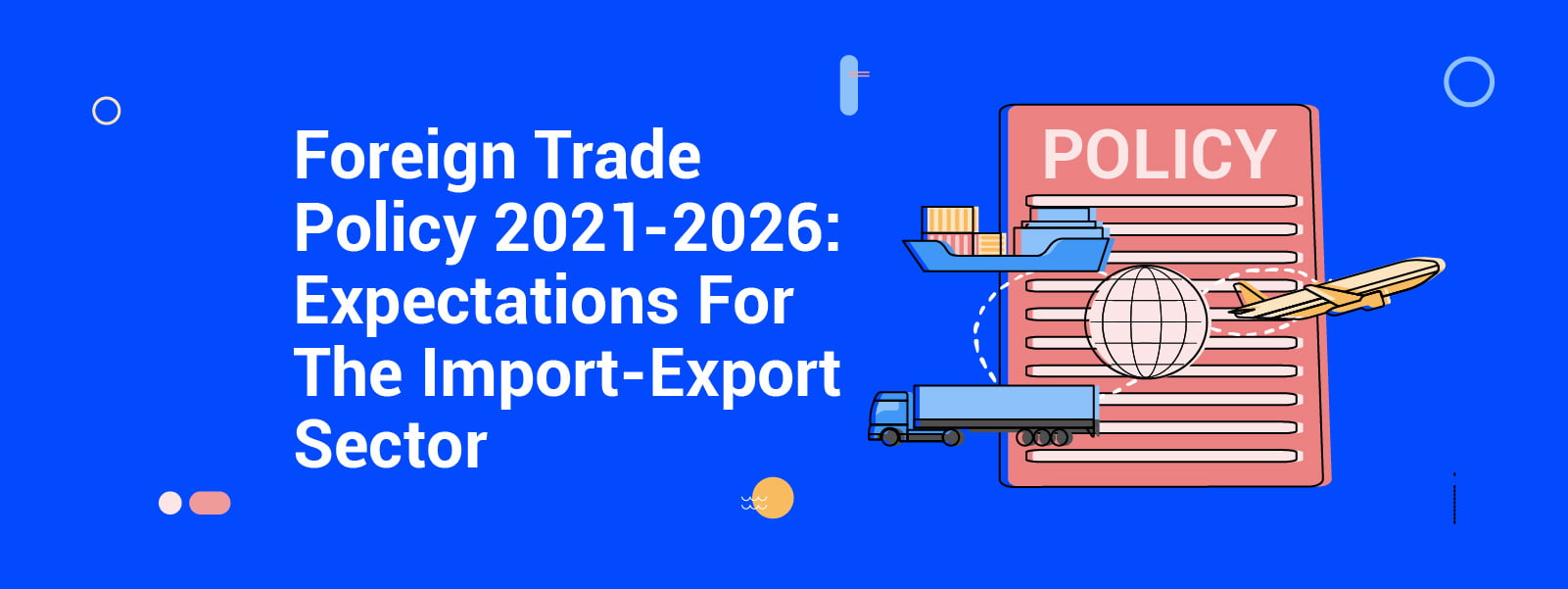.jpg)
On April 1, India was to unveil the Foreign Trade Policy 2021-2026. The existing policy was extended by a year due to Covid-19, which was to end on March 31. And the government decided to further extend it for 6 more months. The current policy will now be valid upto September 30. The foreign trade policy (FTP) outlines government strategies and steps to promote domestic production and exports with the objective of driving economic growth.
It remains to see how the new policy gets affected after India battles the second wave of the pandemic. The new policy is eagerly awaited as the economy continues to reel from the effects of the pandemic and disruptions to international trade caused by lockdowns and restrictions worldwide. The UN World Economic Situation and Prospects 2021 report says India’s economy shrank 9.6% in 2020 against a global average of 4.3%. It projects a 7.3% growth for India in 2021. Hopes for a turnaround rest largely on exports picking up. Exporters expect the new policy to include initiatives aimed at improving India’s standing in global merchandise and services exports and to correct the deficiencies of Foreign Trade Policy 2015-2020.
In this blog, we will discuss:
- What is India’s foreign trade policy?
- What are the highs and lows of the current foreign trade policy?
- What are the expectations from Foreign Trade Policy 2021-2026?
Contents
What is India’s Foreign Trade Policy?
The foreign trade policy is essentially a set of guidelines for the import and export of goods and services. These are established by the Directorate General of Foreign Trade (DGFT), the governing body for the promotion and facilitation of exports and imports under the Ministry of Commerce and Industry. The policy is notified for a period of five years. It is updated every year on March 31, and the changes come into effect from April 1.
While the trade policy covers both imports and exports, its primary objective is to facilitate trade by reducing transaction cost and time, thereby making Indian exports more globally competitive. It aims to:
- Accelerate economic activity and make the most of global market opportunities
- Encourage sustained economic growth by providing access to raw materials, components, intermediates (goods used as inputs for the production of other goods), consumables and capital goods required for production
- Strengthen Indian agriculture, industry and services
- Generate employment
- Encourage stakeholders to strive for international standards of quality
- Provide quality consumer products at reasonable prices
FTP 2015-2020 – Highs and Lows
The current trade policy – which focused on improving India’s performance in existing markets/products and exploring new markets/products – has been praised as “progressive” for the following reasons:
- It consolidated a range of export incentives with different eligibility criteria into two schemes – the Merchandise Exports from India Scheme (MEIS) and Services Exports from India Scheme (SEIS).
- It offered export incentives under these two schemes in the form of duty credit scrips, which can be used by exporters to pay import duties. The scrips are fully transferable, which means that if an exporter has no need for them, they can pass it on to another.
- It reduced export obligation from 90% to 75% for capital goods sourced from local manufacturers under the Export Promotion Capital Goods Scheme (EPCG).
- It allowed manufacturers who are “status holders” (entrepreneurs certified by the DGFT as having helped India become a major export player) to self-certify their manufactured goods as originating from India. This helps them qualify for preferential treatment under various bilateral and regional trade agreements.
- It identified 108 micro, small and medium enterprise (MSME) clusters for focused interventions with a view to boost exports.
- It promoted paperless processing of various DGFT licences and applications.
However, the policy has also had its fair share of criticism. Some of its provisions have been challenged at the World Trade Organisation (WTO) by the United States. Some sticking points:
- In 2019, a WTO dispute settlement panel, acting on Washington’s complaint, said India’s export subsidy provisions violate WTO rules and must be withdrawn. These included tax incentives under the popular MEIS and SEIS. As India’s per capita gross national product is over $1,000 per annum, it can no longer offer subsidies based on export performance, the panel ruled. This controversy reinforces the growing view in India that the country needs to move away from subsidies and think of other ways to help its exporters.
- There is a strong belief in India (bolstered by its trade policy) that free trade agreements (FTAs) haven’t worked for it. One indication of this came in November 2020 when India decided to not be a part of the Regional Comprehensive Economic Partnership (RCEP), the world’s largest FTA. Experts and economists believe this cost India a golden chance to be a major player in exports.
What are the expectations from FTP 2021-2026?
Covid-19 was catastrophic for international trade. Indian exports fell by a record 60% and imports by 59% in April 2020. Though the situation has improved, the road to recovery is long and hard. That is why the new trade policy must deliver the goods. Based on inputs from traders, trade associations, members of Parliament and a government-appointed high-level advisory group, some key expectations are:
- WTO-compliant tax incentives: With incentives under MEIS and SEIS under a cloud, the need of the hour is WTO-compliant tax benefits. To this end, the government has announced the Remission of Duties or Taxes on Export Products (RoDTEP) scheme, effective January 1, 2021. It replaces MEIS. Rates and conditions for the new scheme are yet to be announced.
- Easy credit access: A long-standing demand of exporters, especially MSMEs, is credit access. Formal financial institutions such as banks are reluctant to lend to MSMEs due to their lack of adequate collateral. The policy can help open up alternate credit avenues, such as finance technology start-ups. The advisory group suggests raising borrowing limits at the Export Import Bank of India.
- Infrastructure upgrade: One reason why China is a manufacturing and export powerhouse is its network of ports, highways and high-speed trains, which are among the best in the world. India needs to learn from its neighbour and improve its flagging infrastructure by upgrading existing ports, warehouses, quality testing and certification centres and building new ones. The Trade Infrastructure for Export Sector, a scheme for developing infrastructure to promote exports, was launched in 2017 for a period of three years. Many in the industry hope it will be extended.
- Less subsidy, more support: In 2020, Commerce Minister Piyush Goyal said quality, technology and scale of production were the answers to India’s global ambitions, not subsidies. Many in the industry agree, saying government support in the form of skill development programmes and technological upgradation rather than subsidies would help them become more competitive. Pharmaceuticals, biotechnology and medical devices are some sectors that could do with upskilling. Similarly, the trade policy could include incentives with a focus on research and development, something the government has spoken of in the past. On the technology front, the Amended Technology Upgradation Fund Scheme – which facilitates improvements in investment, productivity, quality and exports in the textile industry through technology upgrades – can be replicated for other sectors.
- Tax breaks: If India were to do away with subsidies, exporters would still need some form of government support. Easier and lower taxes are a way of filling this gap. The reduction of corporate tax rates and simplification of duty structures are long-standing demands. The Confederation of Indian Industry suggests simplifying the import duty structure by following “the general principle of higher duties on finished goods and lower/minimal duties on intermediates and raw material”. There are also demands for an overhaul/improvement of existing schemes such as the EPCG and Duty Drawback Scheme.
- Digitisation and e-commerce: With Covid-19 disrupting traditional supply chains, India needs modern trade practices. Digitisation and e-commerce are two ways to go about this. Digitisation can start with making common import-export processes paperless. Trade body Nasscom, for example, recommends an online mechanism for Importer Exporter Code (IEC) holders to change their particulars (mobile numbers, e-mail IDs, etc). It also makes a case for encouraging e-commerce exports by a) including e-commerce export platforms under Niryat Bandhu (a scheme for mentoring entrepreneurs in international trade), b) establishing e-commerce export promotion cells within export promotion councils, and c) establishing e-Commerce Export Zones to promote MSMEs.
- Export awareness: At times, Indian exporters are defeated not by a lack of trade opportunities but by lack of awareness of the same. The trade policy can make a provision for government workshops and awareness programmes that educate and inform traders about international laws and standards, global markets, intellectual property rights, patents and geographical indication (GI).
- Import wishlist: While most of the expectations might be geared towards exports, India’s import community has its wishlist too, which includes permission to import capital goods on self-certification basis and to import prohibited items with the approval of the Central government-approved Board of Approval or Inter-Ministerial Standing Committee.
Road to $5 trillion by 2025
India aspires to be a $5-trillion economy by 2025. To achieve this dream, it needs to:
- Register a GDP growth rate of 8% or more in the next few years
- Triple its exports to $1 trillion by 2025
This a tough ask, considering Indian exports have hovered around the $300-billion mark since 2011-2012. Battered by the pandemic, exports for the April-November 2020 period stood at $304.25 billion. The country’s GDP reached $ 2.88 trillion in 2019–2020.
In its 2019 report on what India must do for exports to reach $1 trillion by 2025, the high-level advisory group suggested:
- Urgent reform of labour laws
- Easing of regulatory controls
- Lowering the cost of capital
- Selection of right trading partners (given India’s unhappy experience with FTAs)
- Sector-specific strategies to drive exports, especially in pharmaceuticals, biotechnology, textiles and electronics
- The formation of a special committee to take quick decisions on foreign direct investment (FDI), including identifying and attracting potential investors
The government, on its part, seems committed to seriously working towards its $5-trillion dream. Briefing MPs about FTP 2021-2026 on January 12, the Ministry of Commerce announced some of its plans for the new policy. These include:
- District Export Hubs: The government will identify potential products and services in each district, identify agricultural and toy clusters, map GI products, set up district export promotion panels and district export action plans as part of this initiative targeted at small businesses and farmers.
- Correcting imbalances: A persistent demand of exporters/importers is correcting the imbalances in India’s international trade processes. At the meeting, the ministry committed to reducing “domestic and overseas constraints related to the policy, regulatory and operational framework for lowering transaction costs and enhancing ease of doing business”. It also spoke of creating “efficient, cost-effective and adequate logistical and utilities infrastructure”.
If FTP 2021-2026 delivers on the government’s commitments and lives up to industry’s expectations, India as a $5-trillion economy is not a dream too far.
[“source=cogoport”]













































